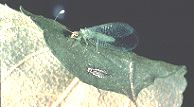
Green lacewings are predatory as larvae. Adult green lacewings are divided into two diet categories: mainly predatory and mainly pollen and honeydew feeding. Even the latter group takes some aphid food and may have higher reproduction when aphids supplement honeydew and pollen. Adults are green with transparent wings having an interconnecting network of fine veins. Eyes are golden in color. Adult length is 6/10 - 9/10 inch (15-22 mm). Adults may often be seen at electric lights during the summer. Flight starts in the early evening, peaking around 9:00-10:00. Adults are attracted by the odor of aphid honeydew and lay their eggs near aphid colonies. Eggs are laid singly in some species, such as Chrysoperla carnea (Stephans), one of the most common species, or in groups. Eggs are suspended at the tops of threadlike stalks to protect them from predation by hatching siblings. Females produce 400-500 eggs each. Larvae (also called aphid lions) are somewhat spindle shaped, with two sickle-like jaws protruding from the head. Larvae reach a length of 1/4 - 1/3 inch (7-10 mm). The first abdominal segment is smaller than the second and third, and the body bears many tubercles with bristles. There is a trumpet-shaped structure (empodium) between the claws. Larvae must detect prey through direct contact. When attacking prey, the larva lunges forward, impaling the aphid. Enzymes are injected through the hollow jaws. After the prey's body contents are digested, they are sucked back through the jaws by the lacewing larva. The long tail section is used as a stabilizing brace when the larva is attacking prey. The larval developmental period is 1-2 weeks; 37-60 days may be required to pass from egg to adult. There are 2-4 generations per year. C. carnea overwinters as an adult (most green lacewings overwinter as pre-pupae), in bark crevices and other protected places.
Chrysopa oculata Say, Chrysoperla carnea, and Chrysoperla rufilabris Stephans appear to be the most important green lacewings in orchards in our region, although other species (e.g., Chrysopa harrisii Fitch, Chrysopa quadripunctata Burmeister, Chrysopa nigricornis Burmeister) have been collected from fruit crops.
Brown lacewings are somewhat smaller than green lacewings. The brown adults often reach lengths of 1/5 - 6/10 inch (10-15 mm); larvae are 15/100 - 1/4 inch (4-7 mm). Adult brown lacewings are predatory. Although many species are more common in low-growing vegetation than in tree canopies, adults are common in apple trees in our area. Brown lacewings often have a lower developmental threshold temperature than their aphid prey, making them useful early in the season. Adults fly earlier in the evening than green lacewings. Females start to lay eggs when 3-7 days old. Eggs lack the stalk found in green lacewing eggs. Eggs are glued to the substrate either singly or in groups (depending on species). Eggs are usually deposited on apple buds or twigs having aphid colonies. Females may lay 100-460 eggs each. Larvae are generally similar in structure to green lacewing larvae, but they lack the trumpet-shaped structure between the claws, bristle-bearing tubercles. The first abdominal segment is the same size as the second and third. Larvae consume more than 20 aphids per day, or 30-40 mites per day. Most species have two generations, but range from 1-5.
A survey of lacewings in Pennsylvania vineyards showed the following brown lacewing species (from greatest to least abundance): Micromus posticus (Walker), M. subanticus (Walker), Hemerobius humulinus L., H. stigmaterus Fitch and Sympherobius amiculus (Fitch). In addition, H. stigma Stephans occurs on apple in Wisconsin. Most of these species have been collected from peach in Georgia as well.